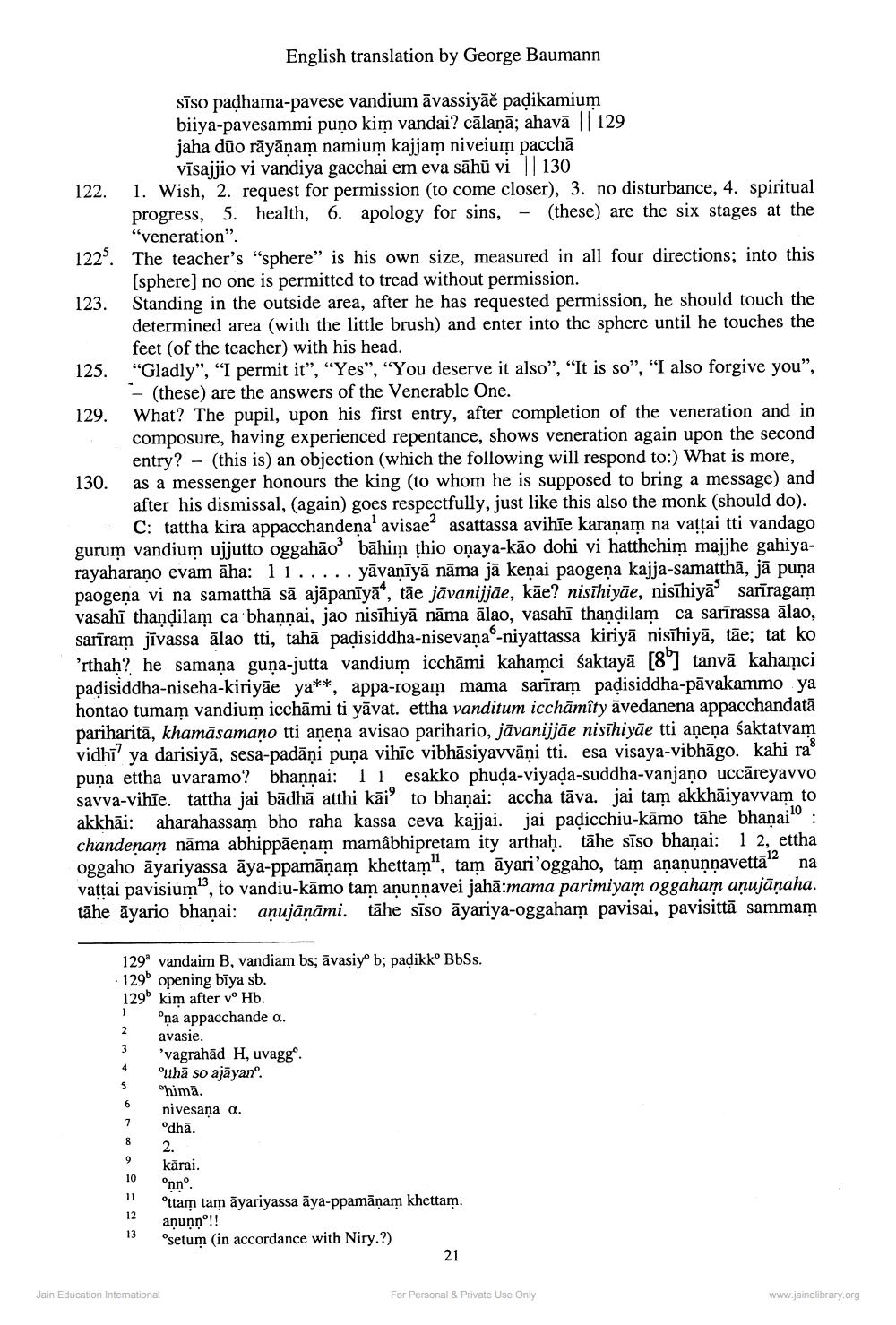________________
English translation by George Baumann
sīso padhama-pavese vandium āvassiyāě padikamium biiya-pavesammi puno kim vandai? cālanā; ahavā || 129 jaha düo rāyānam namium kajjam niveium pacchā
vīsajjio vi vandiya gacchai em eva sāhū vi || 130 122. 1. Wish, 2. request for permission (to come closer), 3. no disturbance, 4. spiritual
progress, 5. health, 6. apology for sins, - (these) are the six stages at the "veneration". The teacher's "sphere” is his own size, measured in all four directions; into this (sphere) no one is permitted to tread without permission. Standing in the outside area, after he has requested permission, he should touch the determined area (with the little brush) and enter into the sphere until he touches the feet (of the teacher) with his head. "Gladly", "I permit it”, “Yes”, “You deserve it also”, “It is so”, “I also forgive you”, - (these) are the answers of the Venerable One. What? The pupil, upon his first entry, after completion of the veneration and in composure, having experienced repentance, shows veneration again upon the second
entry? – (this is) an objection (which the following will respond to:) What is more, 130. as a messenger honours the king (to whom he is supposed to bring a message) and
after his dismissal, (again) goes respectfully, just like this also the monk (should do).
C: tattha kira appacchandena' avisae? asattassa avihīe karaṇam na vattai tti vandago gurum vandium ujjutto oggaho bāhim thio onaya-kāo dohi vi hatthehim majjhe gahiyarayaharaṇo evam āha: 11..... yāvanīyā nāma jā keņai paogena kajja-samatthā, jā puņa paogeņa vi na samatthā sā ajāpanīyā, tāe jāvanijjāe, kāe? nisīhiyāe, nisīhiyā sarīragam vasahi thandilam ca bhannai, jao nisīhiyā nāma alao, vasahi thandilam ca sarīrassa alao, sarīram jīvassa ālao tti, tahā padisiddha-nisevaņa -niyattassa kiriyā nisīhiyā, tāe; tat ko 'rthah? he samaņa guņa-jutta vandium icchāmi kahamci śaktayā [8] tanvā kahamci padisiddha-niseha-kiriyāe ya**, appa-rogam mama sarīram padisiddha-pāvakammo ya hontao tumam vandium icchāmi ti yāvat. ettha vanditum icchāmîty āvedanena appacchandatā pariharitā, khamāsamano tti anena avisao parihario, jāvanijjāe nisīhiyāe tti aņeņa saktatvam vidhi' ya darisiyā, sesa-padāņi puņa vihie vibhāsiyavvāņi tti. esa visaya-vibhāgo. kahi ra® puņa ettha uvaramo? bhannai: 11 esakko phuda-viyada-suddha-vanjaņo ucсāreyavvo savva-vihie. tattha jai bādhā atthi kāi' to bhanai: accha tāva. jai tam akkhāiyavvam to akkhāi: aharahassam bho raha kassa ceva kajjai. jai padicchiu-kāmo tāhe bhanai : chandeņam nāma abhippāenam mamâbhipretam ity arthaḥ. tāhe sīso bhanai: 1 2, ettha oggaho āyariyassa āya-ppamāṇam khettam", tam āyari’oggaho, tam anaņunnavettā na vattai pavisium", to vandiu-kāmo tam aņunnavei jahā:mama parimiyam og gaham anujānaha. tāhe āyario bhaņai: anujāņāmi. tāhe sīso āyariya-oggaham pavisai, pavisittā sammam
1299 vandaim B, vandiam bs; āvasiyo b; padikko BbSs. 1290 opening bīya sb. 1296 kim after vo Hb.
°ņa appacchande a. avasie. 'vagrahād H, uvaggo Otthā so ajāyano Chimă. nivesana a. odhā. 2. kārai. Onno Ottam tam āyariyassa āya-ppamāṇam khettam.
anunno!! 13 °setum (in accordance with Niry.?)
21
Jain Education International
For Personal & Private Use Only
www.jainelibrary.org




